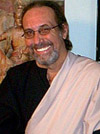Venerable Master Jy Din Shakya, also known as Wei-miao, was the first official voice of Chinese Chan/Zen to enter the West. He arrived in Hawaii in 1956, by order of his master, the Venerable Hsu Yun (Xu Yun) also known as De-qing and Yan-che. His simple directive to Jy Din: "spread the Dharma to the West." Prior to Master Jy Din's arrival, the West had known Mahayana Buddhism solely through the eyes of Japanese Zen and, to a lesser extent, the Chinese Pure Land school. Written by Yu Ling Bo, China.
Original translation to English by Barry Tse, with assistance from Ron Lim
Edited and revised by Fa Dao Shakya, OHY
The original article was published in Chinese in 1997 on the Buddhism City Website
Quotations from Master Jy Din were added in 2009 [1]
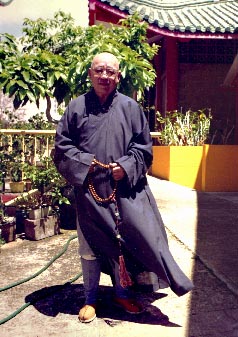
Venerable Master Jy Din Shakya, also known as Wei-miao, was the first official voice of Chinese Chan/Zen to enter the West. He arrived in Hawaii in 1956, by order of his master, the Venerable Hsu Yun (Xu Yun) also known as De-qing and Yan-che. His simple directive to Jy Din: "spread the Dharma to the West." Prior to Master Jy Din's arrival, the West had known Mahayana Buddhism solely through the eyes of Japanese Zen and, to a lesser extent, the Chinese Pure Land school. Theravada Buddhism, practiced in and around Sri Lanka, had also been know to the West by this time. But few had ever heard of Chinese Chan. Through Master Jy Din, Sandalwood Mountain - Honolulu, Hawaii -- would become the birthplace of Chan in the Western Hemisphere. This is the story of Grandmaster Jy Din, his legacy, and the temple he founded in the name of his master, Hsu Yun temple.
Sandalwood Mountain
In the vast Pacific Ocean, there is an archipelago consisting of more than 130 islands and islets. The largest , Hawaii, is the as that given to the archipelago. Its total area is about 16,000 square kilometers. It is about 4,000 km to west of San Francisco, and about 8000 km east of Manila, capitol of the Philippines. Because of its central location in the Pacific, Hawaii is often called the Crossroad of the Pacific Ocean.
The Hawaiian Islands are made up of 8 key islands: its capital, the city of Honolulu, is located on the third largest island, Oahu. The Chinese call this island Sandalwood Mountain.
In the 4th Century A.D., Polynesians migrated by small boats to what is now Oahu. In 1795, Tribal chief Kamehameha-the-First conquered most of the island and established the Kingdom of Hawaii. Prior to 1840, King Kamehameha III had established a national constitution for the chain of islands. Hawaii was recognized as an independent country by England, America, and France. Although American businessmen living in Hawaii, with the help of the US government, took control of Hawaii from Queen Liliuokalani in 1898, it wasn't until 1959 that Hawaii officially became part of the United States - its 50th State.
Honolulu was named Sandalwood Mountain by Chinese immigrants as they arrived during the latter half of the 19th Century, for they quickly discovered that the land was covered with Sandalwood trees. Sandalwood is a sacred plant for Buddhists and Hindus and is used ubiquitously in ceremonies and during meditation to help focus the mind in preparation for meditation. For this reason, Chinese people still retain this affectionate name for the city of Honolulu.
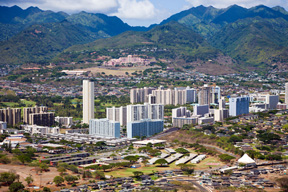
There was no lack of Buddhists among the early Chinese settlers, yet these early Buddhist settlers did little to spread their religion outside their own numbers. In general, they felt that religion was a personal thing. Their purpose for going overseas was, instead, to work and prosper -- not to spread their religion.
Japanese immigrants arrived in Honolulu more than 10 years after the Chinese. Soon after followed Japanese Buddhist sanghas which served their culturally-Japanese populations. While the Japanese founded a Buddhist temple in 1897, it was not until 1950 that a Chinese sangha and monastery appeared - over 50 years later.
The story of the first Chinese temple in Honolulu began in 1930 when a group of Chinese Buddhists, including a Mr. Deng Bian Rong, began a local Buddhist Society. It was a difficult time though, for World War II was about to erupt. It effectively terminated their plans, preventing the visits of many Masters they had invited to help them establish a temple. After the war the effort was revived and finally an official Buddhist organization was established: the Chinese Buddhist Association of Hawaii. The leaders of the effort to establish the organization included Deng Bian Rong, Hu Xing, Chen Zhao Hong, Huang Hua and Huang Bei Hong. The Association was officially established on July 1, 1953. It was the Venerable Master Hsu Yun who sent his disciple and translator, Master Jy Din, from Hong Kong to lead the sangha in Honolulu.
Master Jy Din Brings Chinese Chan to the United States
Master Jy Din was born on September 7th, 1917 (Western and Chinese Lunar Calendar / Year 6 according to the Kuomintang Chinese Calendar) into the Feng family. Remembering his early years as a child, Master Jy Din wrote:
"Originally my family came from Fu Jian Province, but my father moved to Shao Guan and that is where my older brother and I were born and raised. By local standards my family was considered rich. My father owned two businesses: a building materials and supply business and a commercial shop in which he sold dried foods such as mushrooms, scallions, and other varieties of vegetables.
I suppose my parents originally hoped that one day my brother would take over one business and I would take over the other. But my brother's talents were not in any of the academic pursuits and my parents soon began to worry about his abilities. When I was four years old I began to study with the private tutors they had engaged to educate him. He was then two years ahead of me. But I learned quickly and began "skipping" grades until I was ahead of my brother. So, at the conclusion of the Six Year Primary School education, although I was two years younger than my brother, I was graduated two years ahead of him.
At the age of 6, Jy Din began classical studies, but living near Nan Hua Monastery would change his life and the lives of countless others to come. He wrote:
"During the 1920's, when I was still a boy, Xu Yun had not yet come to Nan
Hua Monastery, the monastery which Hui Neng, the Sixth Patriarch of Chan, had
founded near the town of Shao Guan, where I lived. Shao Guan lies about one
hundred miles north of Guang Zhou (Canton) in Guang Dong Province, which is
in the south of China.
In all the centuries since its founding in 675 AD, Nan Hua Monastery had gone through cycles of neglect and restoration; but when I was a boy, it was definitely in one of its neglected phases. As I can clearly remember, it was much more like a playground than the shrine it is today.
"In those days, Shao Guan was a sleepy, little river-town, a place with not much for kids to do. Going out to Nan Hua monastery was our equivalent of a trip to Disneyland.
"What made this Monastery playground even more exciting to visit was that no one seemed to be in charge of it. About a hundred monks and a few dozen nuns lived there, but mostly they busied themselves with bickering. Nuns argued with nuns. Monks argued with monks. Nuns argued with monks. And the buildings of this great religious center were merely the places in which all these arguments took place. It didn't seem to matter that the wood was rotting and the stonework was crumbling and the ironwork of the old red and white pagoda was rusting. The decay had merely kept pace with the decline in monastic discipline. Devout Buddhists, like my parents, would visit and put money in the donation boxes; and if the unruly boys they brought with them, like my older brother and me, climbed on ancient structures, or played hide and seek behind the sacred statuary, or ran through hallowed hallways, well, nobody objected. To have restrained us from enjoying ourselves might have restrained the donations. I suppose the monks figured that they already had to suffer with dilapidated buildings, so why should they risk worsening their problems with financial shortages.
"So we always had a good time whenever we went to Nan Hua. We'd run across the Caoxi (Ts'ao Xi) River bridge and climb one of the nearby mountains in which there was a natural stone niche. The Sixth Patriarch was said to have meditated in this niche. We'd sit in it and laugh, imitating his pious posture. No wonder that the Sixth Patriarch appeared to Xu Yun in a vision and begged him to go to Nan Hua Monastery to straighten out the mess it had become!
"I didn't meet Xu Yun until 1934 when I was seventeen years old and he was in his sixties.
Jy Din graduated from the No. 3 Normal College of Guangdong. It was during these years that he first encountered Xu Yun. He wrote:
"...there I was, in 1934, a cocky kid of seventeen... a smart Alec, you'd say, who one holiday went out, as usual, to Nan Hua Monastery with all the other teen aged boys and girls to have some fun. I had never even heard of Xu Yun and I certainly didn't expect to discover that a holy man had just come to Nan Hua. And there he was...
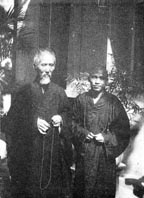
"Something happened to me when I looked into his face. I suddenly dropped to me knees and pressed my forehead against the ground, kowtowing to him. My friends were all astonished. I had never kowtowed to anybody in my life... and there I was, inexplicably, with no suggestion from anyone that I do so, humbling myself before him. Filled with awe and wonder, I kowtowed to Xu Yun three times in succession. The Great Master smiled at me and asked, "Who are you and where are you from?" I barely whispered, "I'm Feng Guo Hua, and I come from Shao Guan." And Xu Yun smiled again and said, "Enjoy yourself here at Nan Hua Temple." He was surrounded by many other monks who looked on silently. I suppose they didn't know what to make of it, either.
"Now I couldn't wait until I returned to Nan Hua... but not to have fun... I wanted to see Xu Yun again.
"The second time I saw him he asked me if I wished to take Buddhist Precepts, that is to say, formally to become a Buddhist. I said, "Yes, of course." And so I received the Precepts from Xu Yun. He gave me the name Kuan Xiu, which means "big and wide practice".
In 1937, at the age of 20, Jy Din received ordination from Hsu Yun and became a monk. He would soon become Master Hsu Yun's personal porter, treasurer, and interpreter.

In 1941, with the permission of Master Hsu Yun, Jy Din went to Jiangsu and continued study at Jiao Shan Buddhist College. He graduated from the College in 1943 and began a pilgrimage, visiting monasteries on foot in the Buddhist tradition. He visited Ji An monastery in Jiangxi Province, where he learned Chan meditation from Master Qing Yuan Xing Si, but within only a few months he returned to Nan Hua Monastery at the request of Hsu Yun, for his master had plans for him.
Jy Din was given the office of Vice Chancellor of Nan Hua Tipikara College. He also took the office of Principal of the Nan Hua Primary School. In addition to tending to the operation of those schools, Jy Din assisted Hsu Yun with the running of Nan Hua Monastery.
In 1944, Hsu Yun moved to Yun Men Monastery and rebuilt Da Jue Monastery while simultaneously administering Nan Hua Monastery. In the following year, 1945, Jy Din became the Director of Nan Hua Temple and the temporary Head of the Monastery. Within a short time, he became a committee member of the China Buddhist Association and the Chief Committee Member of the Shao Guan Branch, dividing his time tirelessly between the running of the Monastery and the handling of official government matters.
In 1947, Master Hsu Yun conducted the Thousand Buddha Grand Ordination at Nan Hua Monastery with Jy Din opening the ceremony. At the completion of the Ordination, several Hong Kong Buddhists invited Hsu Yun to conduct a Water Land Blessing Ceremony in Hong Kong. Master Jy Din accompanied him. During the ceremony, many of the Hawaiian Chinese returned to China to participate in a ceremony for their ancestors' spirits and, while there, they asked Hsu Yun to go to Hawaii to organize the Buddhist Association and establish a place to spread the Dharma. In answer, Hsu Yun pointed to Jy Din and said, "I am too old -- useless. He will complete this task for me, you must wait patiently."
In 1949, the ruling Kuomintang [ Chinese Nationalist People's Party (KMT) ] and Communist armies battled at Xu Pang. The KMT army lost and the Communist army pushed toward Chang Jiang (the Yangtze River). Nan Hua Monastery was severely damaged -- the monks and sangha were confronted with the fear and chaos of war. Despite the horrors that the war inflicted everywhere that year, Hsu Yun conducted ordinations as usual. After the ordinations, Jy Din accompanied Hsu Yun by car to Shao Guan and then to Yun Men monastery.
During the trip we are told that Jy Din said to Hsu Yun, "the whole country is at war, there is no peace anywhere. Local robbers often rob Nan Hua and the countryside has become very frightening. I hope you can send someone to take over my duties at Nan Hua Monastery, for I wish to accompany you to Yun Men to cure my abdominal illness and spend my time there." After a long silence, Hsu Yun replied, "I do not need you to handle the Nan Hua issue, and will not ask you to go to Yun Men. You are in deep trouble if you stay here. You need to leave China and the farther away you go, the more reassured I will be. I will be saddened to see you go, but you have to go as far away as possible to stay safe. Go and do not hesitate. The protection of the Dharma needs people like you. Take care."
When Hsu Yun pointed out that Jy Din was in "deep trouble," he meant that Jy Din had worked with the KMT government senior officials during his years in Nan Hua and (due to the needs of the Buddhist Association) he had to remain in touch with people from all walks of life and political philosophies. If the Communist came, Jy Din's days would be unbearable, thus, Hsu Yun warned him to leave China as soon as he could. After Jy Din heard that, he asked of Hsu Yun, "What happens to you if I leave?"
Hsu Yun replied, "I am old. No matter what happens, there is only a short time that I will remain in this world. I have been 'eating the rice of the patriarchs,' so when there are problems, as there are now, how could I bear it to leave?"
This conversation sealed the fate for the separation between the master and disciple. What Master Jy Din did not know was that he would never again see Hsu Yun after this parting.
After saying goodbye to Hsu Yun, Jy Din went back to Nan Hua and settled his affairs at the monastery. He then set off for Guangzhou. But Jy Din Had continued suffering from an abdominal illness that was not healing. He wasn't well enough to leave. In his ill state, Hsu Yun accompanied Jy Din to Hong Kong where he stayed initially at the Hong Kong Buddhist Association, but later at the home of Mr. Wu Li Xi in Kowloon, one of Hsu Yun's many disciples.
After two months of continued struggle with his illness, , Master Ming Chang sent Masters Wu Yi and Da Dao to help Jy Din to move to Lu Ye Yuan at Tsuan Wan in the Northern Territory. Later, Master Mao Feng asked Jy Din to move to East Pu Tuo Monastery. By this time, the Hawaii Buddhists knew that Master Jy Din had moved to Hong Kong. As a group, the nearly three hundred Hawaiian Buddhists wrote a letter to Master Jy Din asking him to come to Honolulu to establish the Buddhist Association. Considering again Hsu Yun's desire that he go to Honolulu for this cause, he agreed and began instructing the Honolulu group on how to move forward to create the Buddhist Association.
In 1953, it was done. Deng Bian Rong, Hu Xing, and Chen Zhao Hong had established the Overseas Chinese Buddhist Association in Honolulu. Again they asked Master Jy Din to come to Honolulu. Considering that they were now ready for him, and that his health was adequately improved, Jy Din arranged the necessary travel documents and waited for the KMT government of Taiwan to issue a passport. Unfortunately there were arguments among the directors of the Buddhist Association and one of the Directors wrote a letter to the Taiwanese KMT government accusing Master Jy Din of being a member of the Communist Party. The travel documents were therefore not issued. His trip to Honolulu would be delayed for two more years.
In time, Xu Heng in Hong Kong learned about the problem and informed KMT's Minister of Foreign Affairs, Ye Gong Chao , of the situation. Minister Ye then wrote a letter to Master Jy Din apologizing for the delay ordered the official representative in Macau to issue the passport. Master Jy Din finally received his passport in the winter of 1955. After the Chinese New Year, Jy Din boarded a JAL flight and was on his way to Honolulu. It was January 12th 1956 by the lunar calendar.
Building the Hsu Yun Temple
Master Jy Din brought a pioneering spirit to Hawaii. He arrived in Honolulu empty-handed with the exception of statue of the Buddha and a small collection of sutras. Two weeks after his arrival, more than 1,000 Buddhists and overseas Chinese gathered at the Main Hall of Honolulu's Zhong Shan School (Yatsen School) to host a welcoming ceremony. From that day forward Honolulu has had its own resident Dharma Master. After 26 years of perseverance, the Buddha, Dharma, and Sangha were united in Honolulu. The Triple Gem complete.
In the beginning, the Buddhist Association had no permanent address so it used the upstairs floor of the Chen Kuan Market for a temporary office. It was in this Chinese market that the Chairman of the Association, Chen Zhao Hong, called for a meeting of the Directors, and Master Jy Din, to discuss how the Association should best expand its scope considering Master Jy Din's arrival.
Master Jy Din called for discussion during the meeting regarding whether the Association needed a permanent address. If so, he told them, that should be their priority. All of the Directors approved unanimously of the decision to establish a permanent home. Subsequent meetings were then held to discuss other issues such as fund raising and selection of a location. Chen Zhao Hong was among the most dedicated and enthusiastic, but due to his business matters he was not able to devote sufficient time to the progress of establishing the home location. Mr. Cao Tian Qiu quickly stepped in to help by contacting real estate agents and spending a great deal of time looking for suitable sites.
The chosen location for the new temple: #42 Kawananakoa Place
After three realty agents failed to find the right property, either because of price or location, it was Yang Xian Xi, a local Chinese American, who suggested the residence of a former pastor of a Catholic Church. The property was owned by the church and they were delighted to be able to offer it to the Buddhist community. They quickly approved the sale at the low price of US $45,000.
Although the property was at a good price, the cost was still beyond the reach of the Buddhist Association. The Association was quick, though, to follow through on the suggestion made by Cao Tian Qiu to borrow the money from a bank and pay it back over three years. In the end, it took only one year due to the generous donations made by the directors and the community members. The property was to become home to the Main Buddha Hall and shortly thereafter be Master Jy Din would name it after his beloved master, Hsu Yun.
The first big task after purchase of the land was to refurbish the Pastor's residence and create a Buddha Hall where services could be performed. Statues of Bodhisattvas were received as gifts and offerings and quickly turned an ordinary room into a serene and inspiring place of worship. Other buildings would soon follow under Master Jy Din's guidance and directives: a Hall of Good Deeds with a place-of-remembrance for the ancestors and deceased sangha, a funeral chapel, and a Remembrance Hall. Strong support was received from the overseas Chinese who provided resources and guidance.
In 1958, the owners of the neighboring land told the Association that they would like to sell their house to the Association for $54,000. The deal was closed quickly, bringing the total area of the site to nearly 50,000 square meters-a space that would prove sufficient for the future development and expansion of the temple and facilities. Due to the fact that both buildings were wooden structures and had eroded over many years, Master Jy Din considered the need of demolishing the old structures and building the Main Hall of Shakyamuni in their place. But the huge financial investment needed for such an endeavor would not materialize for many years.
In 1959 Master Jy Din suggested they begin building the Main Buddha Hall (The Hall of Shakyamuni). The suggestion was received enthusiastically by the Association, but at the time another nearby temple, the Temple to Guan Yin was being demolished to make way for a road expansion project and the sangha was fundraising to rebuild the temple at another location. Master Jy Din did not want to compete for funds and resources from the overseas Chinese who wanted to support both projects so he decided to postpone the building of the Main Buddha Hall until a later and more convenient time.
Despite an economic recession five years later, it was decided that if construction of the Main Buddha Hall did not begin it might never happen. Construction began in 1964 but it was not an easy task. For starters, there were no architects in Honolulu who could make a design that would conform to traditional Chinese palace-style architecture. Unless an architect was found and assigned to the project, law prevented construction permits from being issued. Eventually, a Chinese-American architect, Mr. Au, was chosen for the job despite his lack of knowledge of traditional Chinese palace architecture and Chinese construction methods. Working closely with Master Jy Din, though, Mr. Au succeeded.
Master Jy Din's knowledge and skills went beyond typical monastic duties, for he also had a thorough knowledge of palace building techniques and design. He enjoyed "getting his hands dirty" - he created a detailed draft of the building, explaining the style, size and traditional construction methods to Mr. Au. After long and repeated discussions and explanations from Master Jy Din, Mr. Au came to fully understand what was needed and created the official set of blueprints for the building.
But once the plans were completed, cost estimates were made. The projected total cost was a shocking $270,000! The cash reserve of the Honolulu Buddhist Association was not even half of that amount at the time. But the project started anyway and in 1965 the news agency of the US Territorial Government of Hawaii reported on the building of Hsu Yun Temple in a news release. The title of the article read "An Hawaiian Buddhist Hall in the Making. An article by the News Authority of US (Oahu)" Below are some snippets from the article relating information about some of the players in the project:
re: the participation of architect William P. Au
"On the windward side of Oahu Island, between the hills that define Honolulu, gigantic land movers are working, digging deep into the fertile land to make Architect William P. Au's project come true -- this is Hawaii's very first Chinese Buddhist Hall."
re: participation of James W. S. Leong
"The Buddhist Hall is expected to be completed by the end of this year. According to the Chinese Buddhist Association in Hawaii, the fund raising target totals US $279,000. Under the leadership of James W.S. Leong, the construction committee Chairman, US $130,000 has already been raised. As to the financial status of the Association, Leong stated that, 'the land on which the Buddhist Hall is built was bought in 1956, which was excluded in the construction cost. An initial US $150,000 had already been committed for Hsu Yun Temple, land cost and what was originally on the land.'
"The Buddhist Association was formed in 1953 by more than 400 Chinese American Buddhists. The purchase of the land had long been decided. The plan to invite a Chinese Dharma master to run the Buddhist Hall was also achieved, and another part of the plan was to build this Buddha Hall."
re: participation of Henry H. Wong
"The Chairman of the (Honolulu Buddhist) Association Henry H. Wong says, 'As early as 1953, members had started arranging to have a monk to run the temple. It was realized when Master Jy Din arrived in Hawaii from Hong Kong in 1956. He is the first Chinese Master to set foot on the land of United States.'
This Dharma Master, 47 years old, served the Venerable Hsu Yun in Guangzhou's Nan Hua Temple 20 years ago and in 1961, he became a United States citizen."
Design and construction of the Buddha Hall required considerable thought and problem solving. The challenge was to use modern construction approaches, and common building materials, that would result in a final product that would mimic traditional ancient Chinese architecture and at the same time blend with the warm weather and lush landscape of Hawaii. Architect Wu Jun was up for the challenge. He had graduated from Hawaii University, Hawaii Zhong Shan Language School, and California State Center of Arts' School and was ready to put his knowledge to work.
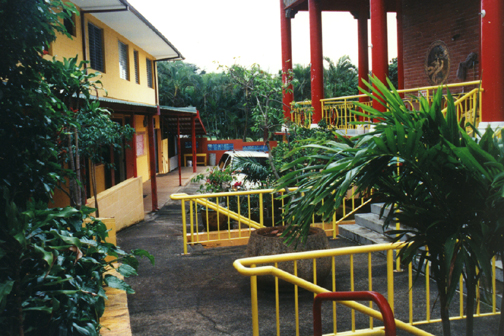 His gallant efforts were noticed locally as well as on the other side of the globe. Between 1965 and 1967, Buddhist publications from Taiwan, Hong Kong, Singapore and Malaysia often reported that the Buddhists of Hawaii were building this Main Hall of Shakyamuni. It was generously called "the Biggest Chinese Temple in the United States."
His gallant efforts were noticed locally as well as on the other side of the globe. Between 1965 and 1967, Buddhist publications from Taiwan, Hong Kong, Singapore and Malaysia often reported that the Buddhists of Hawaii were building this Main Hall of Shakyamuni. It was generously called "the Biggest Chinese Temple in the United States."
But in fact, to have called it the largest Chinese Temple in the history of the Americas at that time would have been no exaggeration. Buddhism in the United States was just budding and there had been no Chinese Temples in the past. The Main Hall of Shakyamuni was to be grand in all ways: it would occupy nearly 6,300 square feet; its two stories with a ceiling height of 34 feet would be fortified against earthquakes; the massive wooden planks would be imported from Hong Kong; and the ceramics and glass for the ceilings would be imported directly from China. To complete the grand structure, an elaborate copper doorframe and ceiling-to-floor glass windows would surround the entryway.
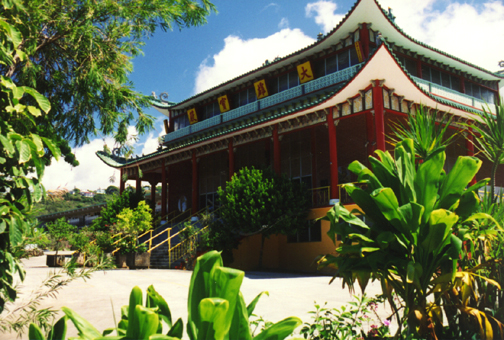
The Hall was completed in 1967, to accolades near and far. Today, the 6,000 square foot first floor, located underneath the Hall of Shakyamuni, is used for private ceremonies and social gatherings. Around the perimeter of the Hall there are wide corridors where people can rest, stroll, and look out at the temple scenery. Today the temple is still as beautiful and grand as on the day it was completed in 1967. On that day Upasaka Wu Pei Lin, Chairman of the Zheng Shan Dharma Study Association, arrived from San Francisco to celebrate the completion of the Buddha Hal and wrote this stanza for the occasion:
"Knowing the essence moves us toward enlightenment and encourages us to give up the bustle of life. Knowing, going beyond dust, beyond love, the Master's power to help all sentient beings is boundless. Yet he comes with only a robe and earthen bowl.
Wind through the coconuts, rain on banana trees, exotic flowers blossoming on tree branches: the sign of the dragon runs wildly in the water. A novice monk can train himself here.
A place of Dharma opens next to Sandalwood Mountain and the faithful and religious gather for the auspicious event. Right Belief disseminates just as Bodhidharma rode on a reed and came from the West.
The sights in Honolulu with their dance of grass skirts -- the islanders are honest and adorable. Let the light of Buddha shine on everyone, to teach and to forget all racial differences."
Dharma Activities and Growth of Hsu Yun Temple
When Master Jy Din first came to Honolulu, he came alone. When the Buddha Hall project began he realized that the community would need more help than he alone could provide so he called upon Master Fa Hui (Fat Wai). He arrived in Honolulu from Hong Kong in October 1956.
 Master Fa Hui was originally from Pan Yu in Guangdong Province. Born in November 1928 to a family with 8 siblings, his father ran his own business while, in the common tradition, his mother cared for the children and household. Fa Hui started schooling at the age of 6, but when the Japanese invaded (Canton area invasions were in 1937-38) the family fled to Shao Guan.
Master Fa Hui was originally from Pan Yu in Guangdong Province. Born in November 1928 to a family with 8 siblings, his father ran his own business while, in the common tradition, his mother cared for the children and household. Fa Hui started schooling at the age of 6, but when the Japanese invaded (Canton area invasions were in 1937-38) the family fled to Shao Guan.
While taking refuge from the war at Nan Hua Temple in Shao Guan, Master Fa Hui had the opportunity to get close to Hsu Yun. He observed the chanting and ceremonies conducted in the Temple and asked Hsu Yun to allow him to give him precepts. In 1944, while following Master Hsu Yun to Yun Men Temple, Master Hsu Yun gave precepts to the young man and gave him his first dharma name. He was 17 years old.
In the Spring of 1945, Shao Guan and Nan Hua Temple conducted ordination in the Spring. Fa Hui received Full Ordination under Master Chuan Ying Shakya then promptly entered Nan Hua Yinaya College to study. During that time, Master Jy Din was the Vice-Chancellor of the College. According to Master Jy Din, Fa Hui was an honest and good student.
In 1950, when the ruling party in China changed, Master Jy Din sent a letter to Fa Hui to ask him to go Hong Kong by any possible means. Fa Hui arrived in Hong Kong from Guangzhou and stayed at Deer Park with Master Jy Din. Then, in 1953, Fa Hui was accepted into Hong Fa Jing She's Hua Nan Buddhist College where he studied under Master Dan Hsu.
When he received the call from Master Jy Din in 1956 to move to Hawaii, Fa Hui, although he had not yet completed his study at the college, decided to forfeit his formal education and traveled to Honolulu. He thus became the second Chinese monk residing in Honolulu, to have arrived only 9 months after Master Jy Din.
After a short time at the temple in Honolulu under Master Jy Din's directorship, Master Fa Hui became responsible for the renovation of the early Buddha Hall. Later on, when the Association started construction of the new Hall of Shakyamuni, Master Fa Hui started taking care of other aspects of the construction projects as well.
Over the past 40 years, besides caring for many temple matters, Master Fa Hui has hosted numerous dharma talks. He has given speeches on Mahayana Sutras such as the Vimalakirti Nirdesa sutra, the Buddhavatamsaka Mahavaipulya (Heart) sutra, and Flower Garland sutra.
As of today, 1997, there are 8 residing monks in the Hsu Yun Temple. Besides the founder and Abbot, Master Jy Din Shakya, and Master Fa Hui Shakya, there are also monks Fa Liang, Ling Wu, Yi Zhao, Yin Lang, Dun Sheng and Dun Yang.
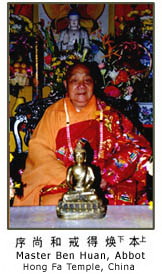 In 1991 Master Jy Din saw again the need for additional clerical help at Hsu Yun temple and corresponded with his good friend, Master Ben Huan, then Abbot of Hong Fa temple. It was agreed between them that Master Yin Lang, Master Ben Huan's disciple, would be asked to move to Honolulu to assist Master Jy Din with running the temple. He accepted the assignment and eagerly moved to the United States. Yin Lang continued to serve under Master Jy Din until his early death from illness in 2000.
In 1991 Master Jy Din saw again the need for additional clerical help at Hsu Yun temple and corresponded with his good friend, Master Ben Huan, then Abbot of Hong Fa temple. It was agreed between them that Master Yin Lang, Master Ben Huan's disciple, would be asked to move to Honolulu to assist Master Jy Din with running the temple. He accepted the assignment and eagerly moved to the United States. Yin Lang continued to serve under Master Jy Din until his early death from illness in 2000.
In memorial, a little more about Master Yin Lang. Encouraged by his family, Yin Lang first become a monk in 1982 at Hua Yan Temple in Ning De. He studied Buddhism at Shuzhou's Ling Yan Mountain Buddhist College and thereafter became the temple supervisor at Dan Xia Mountain. He quickly became Vice Chairman of Shao Guan City Buddhist Association and supervisor of Hong Fa temple in Shen Zhen. He was deeply loved by Master Jy Din who shed many tears over his unexpected and untimely death.
Jy Din's 40 Years of Spreading the Dharma in the West
When he first arrived in Hawaii in 1956, Master Jy Din was only 40 years old. On the first writing of this biography he was 80 and appeared old and fragile. In his 40 years of effort spreading the Dharma in the West, none had been wasted. In June 1995, I visited Hsu Yun Temple for one week and was fortunate to have been able to spend much time with Master Jy Din. I saw that many people treated him as a dear friend - a beloved grandfather, respected for his kindness and humility. Descendent of the Cantonese, he was among the same heritage as more than 80% of the Chinese population on the island. The combination of his Chinese background and religious faith made him extraordinarily popular among the ethnic Chinese population in Honolulu.
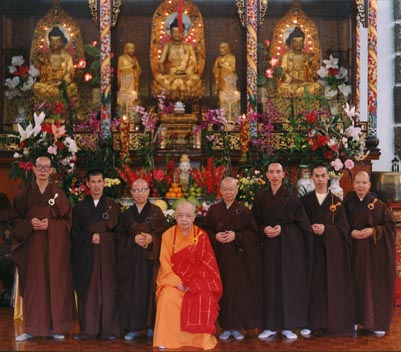
During my week-long visit, I found Master Jy Din to be high-spirited despite his seeming frailty and age.He never skipped a prayer session in the morning or the evening. He was well learned and seemed to understand the Dharma in all its many facets . Over the years, he wrote many books including "Brief Explanations on the Surangama Sutra," "Remarks On the Amitabha Sutra," "Talks On the Bodhisattva-pitaka Sutra," "Remarks On the Prajbaparamitahrdaya Sutra," "Remarks On the Universal Doors," and " A Brief History of the Venerable Master Hsu Yun."
Hawaii is at the central axis of the Pacific Ocean transportation routes and the Venerable Master Jy Din was the first monk from China to arrive here. In the early days all flights to the United States from Hong Kong and Taiwan stopped here to refuel. Later on, monks transiting to the United States also stopped over would stay at Hsu Yun Temple. They would always be warmly received by Master Jy Din. The Hsu Yun temple has provided convenience to masters going to United States to spread the Dharma, and in this sense, Master Jy Din served as a valuable confluence for the Chinese Buddha-Dharma as it moved westward.
End notes
1. Quotes from Master Jy Din were originally published in EMPTY CLOUD - THE TEACHINGS OF XU YUN, by Jy Din Shakya, in Teachings of Tsao Chi, Book IV. Printed by H.K. Buddhist Book Distributor for free distribution, 1995.
Post Script by Rev. Fa Dao Shakya, OHY
This article was researched and written in its original form in June of 1995 and published in 1997. By November of 1997, Master Jy Din had established an order of American Priests to facilitate spreading the Dharma via the Internet into the Anglo-European population of the United States and Europe. This order of priests (organized in the semi-monastic tradition of Zen Teachers euphemistically referred to in Chinese Monastic lore as "vegetable sellers") became our own Zen Buddhist Order of Hsu Yun. In May of 1998, Master Jy Din escorted Chuan Zhi Shakya to China for training and formal ordination as Abbot of the Order of Hsu Yun (OHY). Rev. Chuan Zhi remains Abbot of the Order to this day.
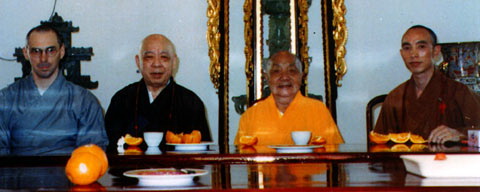
This biography of Master Jy Din and the closely related historical perspective on Hsu Yun temple is a translation from the Chinese of a biography of Master Jy Din -- the Master responsible for the establishment of our Zen Buddhist Order of Hsu Yun.
This "story of the story," however, is one of convergence, patience, and luck -- if we consider "luck" to be the melding of opportunity and action.
I had long wished to know more about the founding master of our order and history of the Hsu Yun Temple in Honolulu. Like many of us, I had scoured books and websites for the merest mentions or tidbits of facts. Not being even a whit knowledgeable of Chinese language, any documentation in Master Jy Din's native language was beyond my grasp. I read what I could find -- and waited. I hopped that someday I would stumble across that which I sought, if only I did not drive myself to distraction desiring it.
Late in July of 2005, that which I had sought was unexpectedly delivered to me.
By chance and good fortune, I received an e-mail from Barry Tse, in Singapore -- the continuance of a discussion we began on an internet "chat board." As the e-mail discussion continued, Barry mentioned an article he had found on a Chinese Buddhist website -- a biography of the founder of our Order, Jy Din. He pointed out the website to me and I printed a copy of the article for my files.
Meanwhile, my children had discovered a new favorite eatery for our regular Wednesday night dinners -- the East Buffet. The East Buffet is a warm and friendly place with wonderful staff as well as a delicious range of succulent foods from many regions of China -- including a full "sushi bar" and Mongolian-style grill. It was there that I met the second man who would be key to the preparation of the article you are about to read.
Ron Lim, the restaurant proprietor with whom I had struck an acquaintance as a "regular" in his establishment, agreed to look over the printed Chinese article that Barry had pointed out. Ron (born in Malaysia but educated and living in the U.S. for several years) said he might not be able to translate word-for-word but was willing to give me a meticulous synopsis of the article.
Barry, in the meantime, agreed that he would translate the article "in-depth" but questioned his own proficiency in grammar and sentence structure. Thus it was that this article came about. Barry Tse of Singapore supplied excellent translation, Ron Lim acted on occasion as an excellent cultural "bridge" in clarifying delicate character meanings, and I have supplied the "editorial functions" of English grammar and sentence structure.
Ron studied Buddhism as a young man in his native Malaysia and prepared a college thesis on the symbolism of the Yin-Yan. He has kept an interest in the religion as he made his way into the ranks of restaurateurs and has kept his interest in the Dharma despite the demands of his rigorous occupation. Barry is a researcher and consultant who is also a student of VM Xin Jue in China. Barry is presently assisting this Master in funding preservation and renovation of the ancient Jiang Ju Si temple in Hubei Province (China).
Without these two men, all that I could have presented for you would have been a desire to know -- a desire already shared by many in our Order. Thus it is that any thanks that might be due for the appearance of this article should rightfully go to Barry and Ron. My deepest gratitude goes out to these humble, kind and intelligent. Both have apologized to me on occasion that their abilities at formal English grammar may not be "up to snuff." My response to the gentlemen is and remains -- do not be ashamed if you can lift a bus but cannot throw it all the way to Hong Kong.
Barry and Ron have done the "heavy lifting" here -- all I have done is to tidy up rows of English words. And that is the story of the story. By the fortunate convergence of three minds and three hearts, we have the following Biography of Master Jy Din.
Namo Amitofo, Fa Dao Shakya
